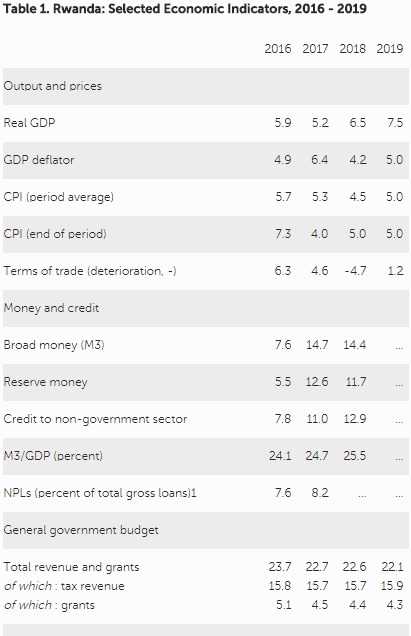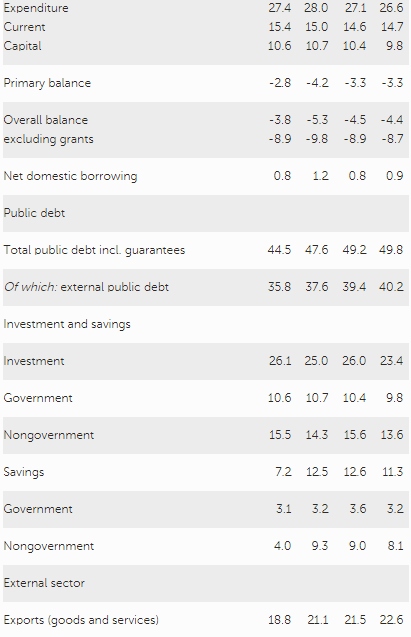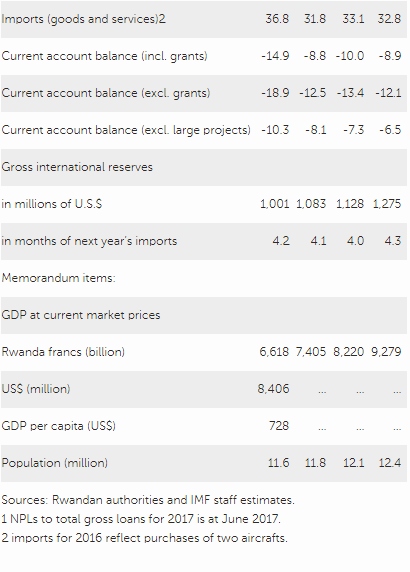IMF Executive Board Completes Third SCF and Eighth PSI Reviews for Rwanda, Approves US$25.8 Million Disbursement Under the SCF, and Extends the PSI
● Completion of the third SCF review enables the disbursement of US$ 25.8.million.
● Performance under the PSI-supported program and SCF arrangement remained strong.
● Rwanda’s growth in 2016 and early 2017, while below historical standards, remained robust relative to the region, with 2017 growth estimated at 5.2 percent.
The Executive Board of the International Monetary Fund (IMF) on January 12, approved the extension of the Policy Support Instrument (PSI) for Rwanda to December 1, 2018 and completed the eighth review of Rwanda’s performance under the PSI and the third and final review of the arrangement under the Standby Credit Facility (SCF).
Completion of the third SCF review enables the disbursement of US$ 25.8.million (SDR 18. 0225 million), bringing total disbursements under the arrangement to SDR 144.18 million, about US$206.6million.
Requests for an 18-month SCF arrangement with access of about US$204 million (SDR 144.18 million) or 90 percent of Rwanda’s quota and to extend Rwanda’s PSI-supported program through end-2017 were approved by the Executive Board on June 8, 2016. Both were again extended on November 29, 2017 to January 31, 2018.
Following the Executive Board discussion, Mr. Zhang, Deputy Managing Director and Acting Chair, made the following statement:
“Rwanda has made notable progress in reducing external imbalances which has helped safeguard macroeconomic stability and improved prospects for long term growth. Exchange rate adjustment has been the central tool of policy adjustment, supported by public spending restraint and prudent monetary policy. Combined with targeted policies to promote domestic production, these policies have reduced the current account deficit and should place external balances on a sustainable path over the medium term. Performance under the SCF arrangement and PSI-supported program has been strong.
“After a slowdown in 2016 and early 2017, growth has started to recover, led by agriculture and services. Over the course of the next two years, growth is expected to return to its historical average of 7-7.5 percent, supported by investments in public infrastructure and interventions promoting structural transformation and diversified exports. After spiking in early 2017, headline inflation has declined rapidly as food supplies have recovered from the drought, and is expected to remain low in the near term. Inflation could pick up gradually over the course of 2018 as growth accelerates.
“Despite these achievements, the Rwandan economy remains vulnerable to external shocks and fiscal risks. It will be important to continue building foreign exchange reserve buffers to enhance resilience while working to identify and mitigate potential fiscal risks.
“Building on its notable progress toward development objectives, the authorities are crafting a revised medium term development strategy with the goal of achieving middle income status by 2035. To help achieve this objective, it will be important to regain momentum in mobilizing domestic revenue as a reliable source of financing for development.”
Recent economic developments
Rwanda’s growth in 2016 and early 2017, while below historical standards, remained robust relative to the region, with 2017 growth estimated at 5.2 percent. A growth recovery began in Q2 2017 and strengthened in Q3, with growth expected to revert to historical averages
(7–7.5 percent) over the next two years. The trade deficit continued to narrow as growth in export volumes outpaced that of imports, partly reflecting the impact of exchange rate adjustment and structural policies. As such, the current account deficit is expected to improve from 14.9 percent of GDP in 2016 to 8.8 percent in 2017.
Consumer price inflation has continued to decline since February 2017, with year-on-year inflation at 2.3 percent in November, 2017, reflecting improving food supply conditions and declining transport costs. Inflation is expected to close the year below the central bank’s medium-term target of 5 percent, but should pick up toward the target as growth accelerates. In the face of lower inflation and the tapering off of exchange rate pressure, monetary policy has been relaxed, with the policy rate adjusted downwards by a cumulative 100 basis points since November 2016. The fiscal policy stance for FY2018/19 has been slightly relaxed, while maintaining the medium-term path of adjustment.
Performance under the PSI-supported program and SCF arrangement remained strong. Most quantitative targets and structural reform benchmarks were met, except for a target on domestic arrears at end-June 2017 and a planned measure to roll out a pilot for electronic billing machines. The latter was intentionally delayed in favor of the use of newer and less costly software that achieves the same purpose.
Program summary
The existing PSI and SCF arrangement have supported Rwanda’s efforts to address external imbalances, thereby supporting continued strong growth and durable poverty reduction. The SCF arrangement added a financing component to the existing PSI-supported program, which aims to promote private-sector led growth through safeguarding macroeconomic stability, including through external sustainability, fiscal sustainability based on continued improvements in domestic resource collection, low and stable inflation, and enhancing access to credit and deepening the financial sector.



Source: International Monetary Fund
- 378 reads
Human Rights
Fostering a More Humane World: The 28th Eurasian Economic Summi

Conscience, Hope, and Action: Keys to Global Peace and Sustainability

Ringing FOWPAL’s Peace Bell for the World:Nobel Peace Prize Laureates’ Visions and Actions

Protecting the World’s Cultural Diversity for a Sustainable Future

Puppet Show I International Friendship Day 2020

